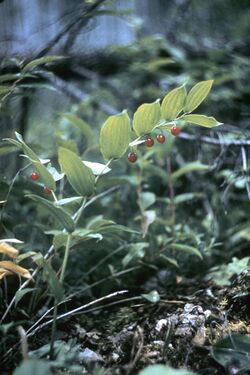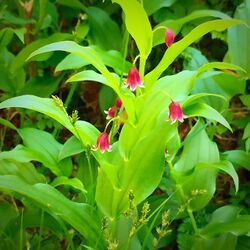Biology:Streptopus lanceolatus
| Streptopus lanceolatus | |
|---|---|

| |
| Scientific classification | |
| Kingdom: | Plantae |
| Clade: | Tracheophytes |
| Clade: | Angiosperms |
| Clade: | Monocots |
| Order: | Liliales |
| Family: | Liliaceae |
| Genus: | Streptopus |
| Species: | S. lanceolatus
|
| Binomial name | |
| Streptopus lanceolatus (Aiton) Reveal
| |
| Synonyms[1] | |
| |
Streptopus lanceolatus (rose twisted stalk, rosybells, rose mandarin, scootberry, liverberry, rose-bellwort), is an understory perennial plant native to the forests of North America, from Alaska to Labrador, south through the Great Lakes and Appalachian Mountain regions of the United States , as well as Montana, Washington (state) , Oregon, and St. Pierre & Miquelon.[2][3] It grows primarily in mixed-wood forests, and throughout a wide range of soil and site conditions, preferring cool, acidic soils.
Streptopus lanceolatus grows from a rhizome or seed, the stem having a zigzag shape, branched or sometimes unbranched. Up to 30 cm (12 in) tall with alternate wide lanced oval-shaped leaves with pointed tips and a rounded base, without leaf-stalks. The leaves are often finely toothed having fine hairs on the underside veins. Flowers appear as solitary individuals opposite each leaf in early summer (May to July) and are bell-shaped on 1–3 cm (0.4–1.2 in) long stalks bent midway, with 6 rose or white recurved petals with purple streaks. Fruit is an elongated red berry ripening in mid-summer (July to August). If berries are consumed in quantity, diarrhea can result.[2][4][5]
Streptopus lanceolatus can be distinguished from Solomon's seal and false Solomon's seal by the alternate leaves on a zigzag stem.

References
- ↑ "Streptopus lanceolatus". World Checklist of Selected Plant Families (WCSP). Royal Botanic Gardens (Kew). http://www.theplantlist.org/tpl1.1/record/kew-287979.
- ↑ 2.0 2.1 Utech, Frederick H. (2002), "Streptopus lanceolatus", in Flora of North America Editorial Committee, Flora of North America North of Mexico (FNA), 26, New York and Oxford, http://www.efloras.org/florataxon.aspx?flora_id=1&taxon_id=242101973
- ↑ "Streptopus lanceolatus", County-level distribution map from the North American Plant Atlas (NAPA) (Biota of North America Program (BONAP)), 2014, http://bonap.net/MapGallery/County/Streptopus%20lanceolatus.png
- ↑ Reveal, James Lauritz (1993). "Streptopus lanceolatus". Phytologia 74 (3): 187. https://www.biodiversitylibrary.org/page/13067481#page/21/mode/1up.
- ↑ Aiton, William (1789). Hortus Kewensis. 1. p. 434. http://www.botanicus.org/page/852413., as Uvularia lanceolata
Wikidata ☰ Q3500354 entry
 |


